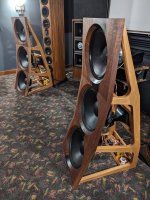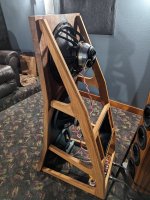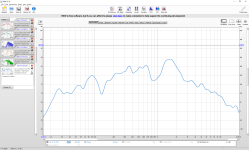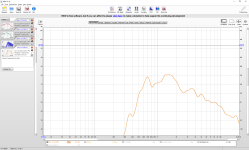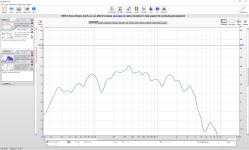I still wonder if a somewhat equaly good horn driver combo firing backwards would benefit the sonics of this dipole.
It just feels wrong using a boutiqe beryllium driver together with this cheap PVR horn.
As a test a mono signal could be used. Using lets say the left speaker turned around right next to the right speaker but only the comp. driver hocked up.
If this was done in the middle of the room the PVR horn could be on one side and the turned around speaker on the other
That could give a good indication of what sounds better.
It just feels wrong using a boutiqe beryllium driver together with this cheap PVR horn.
As a test a mono signal could be used. Using lets say the left speaker turned around right next to the right speaker but only the comp. driver hocked up.
If this was done in the middle of the room the PVR horn could be on one side and the turned around speaker on the other
That could give a good indication of what sounds better.
Well I finished my bitches brews last night. Everything is all set up. However, now I'm entering the part of the project where I need some help. I need to set up the MiniDSP with the FIR filters and set it up for bi-amping. I know the original files were for the MiniDSP 2x4HD, and I have the MiniDSP SHD. Have any new files been created since the ones linked in the evo2.org write-up? I'm also using the 14cxn88 instead of the 15cxn88, so I assume I'd have some tweaking to do regardless. I've never done this part before so I could use some direction!
Beautiful work, Subs!! 🥰 I can't wait to hear your thoughts once the DSP is tuned up. I'm currently considering between the NX Treme and a variation of the Bitches Brew – not many have had the chance to experience both in a well-configured setup. This promises to be quite intriguing, and I'm eagerly anticipating your insights. 

Here are my current Bitches Brew files for the MiniDSP Flex Eight. I seriously doubt these will work directly with the SHD.Well I finished my bitches brews last night. Everything is all set up. However, now I'm entering the part of the project where I need some help. I need to set up the MiniDSP with the FIR filters and set it up for bi-amping. I know the original files were for the MiniDSP 2x4HD, and I have the MiniDSP SHD. Have any new files been created since the ones linked in the evo2.org write-up? I'm also using the 14cxn88 instead of the 15cxn88, so I assume I'd have some tweaking to do regardless. I've never done this part before so I could use some direction!
I believe you will need to open them in the MiniDSP Device Console and carefully hand-copy all of the settings of each filter and crossover slope.
You will find that channels 5 and 6 are settings for a subwoofer that you may not be using, or if you use a sub the settings will be entirely different.
You will find EQ settings in the bass, for example a 75Hz dip, which are applicable only to my room and should be taken out or moved to some other frequency.
Don't miss the 6KHz 6db/octave filter on the tweeters! It counteracts the tapering downward response of the coax horns and the total combination of everything still rolls off the horns below 1.1Khz. The passive capacitors in the BB's roll off the horns below 300Hz and do not effectively factor in to the crossover design.
With the SHD you will not need my FIR filters. The Bitches Brews use the exact same overall strategy as I use in the Live Edge Dipoles, which is explained here:
https://www.diyaudio.com/community/...ompetition-updated-design.405104/post-7498305
In the Bitches Brews, the FIR filters perform a 360 degree phase correction and fine-grained EQ of the top 2 octaves. The Dirac in the SHD will take care of that for you. Of course the 14CXN88s will be slightly different and you can adjust for that with measurements, no problem.
So copy the standard IIR filters, get as close to flat as you can, then apply Dirac from the SHD and you should be good to go.
GORGEOUS cabinet work!
Attachments
Last edited:
Thanks very much Perry! I'm going to have to sit down with this and try to figure out how this all works. I may have further questions, but being able to just use the basic crossover functions of the MiniDSP and then doing the rest of the correction with Dirac makes it much easier than I was thinking.
I'm also struggling with how to set my amps up. They are both integrated tube amps (pretty much all my amps are integrated tube amps) and so they have volume controls on them. Obviously the volume controls would need to remain static or all the correction is going to be wrong. You'd think maybe to just run them both at 100% all the time and do the volume control from the MiniDSP, but I get a pretty distinct hum when I do that. I'm toying with running the volume on the integrated's at around 40-50%, but I'm not sure if this is the right way to do it. I'm pretty sure that most people aren't bi-amping with integrated amps in the first place!
MtlJazz - thanks for the compliments! Yes, I really need to get all the DSP dialed in before making any meaningful comparisons. Right out of the "box" the BB's sound pretty good, but they're still pretty far from what the NX-Treme's are doing. Most of the differences are in the imaging and clarity departments - which are areas I expect the DSP to make the most difference. Additionally, the drivers are nowhere near broken in yet. What I do feel pretty confident in saying, is that the presentation is different. The NX-Treme's have that "wall of sound" characteristic that I quite like, while the BB's sound smaller. You get that same "wall of sound" from other line source and line array speakers as well as planars like the Magnepans. Personally I'm a big fan of that type of "immersive" sound, but it's actually not the last word in a truly faithful reproduction. Things can tend to sound bigger than they would at a real, live event, for example.
I'm going to spend some time trying to get these dialed in, get the room position just right, get the drivers broken in, and then I'll be able to give a listening impressions report. Just from what I can tell so far, I expect these to be quite good when it's all said and done.
I'm also struggling with how to set my amps up. They are both integrated tube amps (pretty much all my amps are integrated tube amps) and so they have volume controls on them. Obviously the volume controls would need to remain static or all the correction is going to be wrong. You'd think maybe to just run them both at 100% all the time and do the volume control from the MiniDSP, but I get a pretty distinct hum when I do that. I'm toying with running the volume on the integrated's at around 40-50%, but I'm not sure if this is the right way to do it. I'm pretty sure that most people aren't bi-amping with integrated amps in the first place!
MtlJazz - thanks for the compliments! Yes, I really need to get all the DSP dialed in before making any meaningful comparisons. Right out of the "box" the BB's sound pretty good, but they're still pretty far from what the NX-Treme's are doing. Most of the differences are in the imaging and clarity departments - which are areas I expect the DSP to make the most difference. Additionally, the drivers are nowhere near broken in yet. What I do feel pretty confident in saying, is that the presentation is different. The NX-Treme's have that "wall of sound" characteristic that I quite like, while the BB's sound smaller. You get that same "wall of sound" from other line source and line array speakers as well as planars like the Magnepans. Personally I'm a big fan of that type of "immersive" sound, but it's actually not the last word in a truly faithful reproduction. Things can tend to sound bigger than they would at a real, live event, for example.
I'm going to spend some time trying to get these dialed in, get the room position just right, get the drivers broken in, and then I'll be able to give a listening impressions report. Just from what I can tell so far, I expect these to be quite good when it's all said and done.
👍Lighting in my listening room sucks, but you get the idea.
Perry, I have copied all the settings over and getting ready to try to apply them. However, with respect to Dirac, I think I can only apply Dirac to 2 channels. Would you recommend I apply that to the low frequency channels or the high frequency channels? Conventional wisdom would indicate that Dirac would be more effective in the lower frequency range - but your description made it sound as if the upper frequency range needs a phase correction that would be taken care of in that way. What are your thoughts?
I suggest you run your tube amps at 50% volume. Maybe even 25%. It's VERY common for amps to be too noisy for the BB's with 100-106dB SPL for 2.8V. John Hilgers had the same problem. When I run these with Adcom GFA 2535s, I turn the input controls halfway down.
I don't know the SHD but I sure would have thought the Dirac applied to the 2 input channels, not the outputs. That's how the Dirac version of the 2x4HD works. It's also how the FIR works on the Flex Eight. So I'm going to guess it EQs the entire system and not just 2 channels.
If I'm wrong, then apply it to the LF since that's where the room problems occur. The phase rotations of the tweeter are by no means a deal killer.
But again I think the Dirac operates on inputs.
I don't know the SHD but I sure would have thought the Dirac applied to the 2 input channels, not the outputs. That's how the Dirac version of the 2x4HD works. It's also how the FIR works on the Flex Eight. So I'm going to guess it EQs the entire system and not just 2 channels.
If I'm wrong, then apply it to the LF since that's where the room problems occur. The phase rotations of the tweeter are by no means a deal killer.
But again I think the Dirac operates on inputs.
You were absolutely right, I noticed it before you responded - I had to select that I wanted to apply Dirac 1 and Dirac 2 to channels 3 and 4 respectively. However, now I have a different issue. I faithfully recreated the EQ settings for the SHD from your Flex 8 file. The curves look identical and I also applied the crossover for the upper frequency range, the inversion on the upper frequency range and tweaked the time delays. I applied that and it sounded AWFUL. Way, way off. Much worse than with just the passive crossovers alone. I ran a frequency sweep on REW and it was all over the place. At that point there could have been a volume matching issue between the 2 integrated amps (both set at 50%), but that wasn't it. There were peaks and nulls all over the place, 10+ dB swings. I ran Dirac and that ended up producing something that wasn't too bad, but still sounded not quite right.
I ended up disabling all of the PEQ settings and simply setting up simple crossovers for the low and high frequencies. I left the high frequency crossover the way you set it up, and then I crossed the lows at 1700Hz with a pretty gradual dropoff and also set up a high pass at around 50Hz to hand off to the subs. Then I ran Dirac again and it produced a better result. However it still just doesn't sound quite right. It sounds a little bright, which it didn't without any DSP at all, and I can't really put my finger on it but it just sounds slightly off. I want to run a frequency sweep with ALL of the corrections in place - the digital crossovers as well as the Dirac corrections to see what things look like, but I can't find a way to do that. Is there a way to run the REW sweep signal through the MiniDSP so I can see what it's actually doing with all the corrections?
Any other suggestions?
I ended up disabling all of the PEQ settings and simply setting up simple crossovers for the low and high frequencies. I left the high frequency crossover the way you set it up, and then I crossed the lows at 1700Hz with a pretty gradual dropoff and also set up a high pass at around 50Hz to hand off to the subs. Then I ran Dirac again and it produced a better result. However it still just doesn't sound quite right. It sounds a little bright, which it didn't without any DSP at all, and I can't really put my finger on it but it just sounds slightly off. I want to run a frequency sweep with ALL of the corrections in place - the digital crossovers as well as the Dirac corrections to see what things look like, but I can't find a way to do that. Is there a way to run the REW sweep signal through the MiniDSP so I can see what it's actually doing with all the corrections?
Any other suggestions?
Can you run separate frequency response curves for both LF and HF sections with NO DSP crossovers, just the standard passive components, and post them here?
My philosophy is: Never use nuclear weapons when you can use a bow and arrow instead.
@Subsonic1050 I played with the Bitches Brew crossover a little more and since the 14CXN88 is going to be a little different anyway, you can use my overall approach with whatever differences you encounter. There are nuances I deem important to get good phase, step and impulse response, with as little FIR DSP "cheating" as humanly possible.
(I don't have anything against FIR, but many DSP processors only have 2 FIR channels. You don't get separate FIR for each driver, so you have no choice but to use it sparingly.)
Below: acoustic slopes, microphone about 0.5M away from the 15CXN88. If I had a magic genie I'd have 6dB acoustic slopes both directions, but that's impossible. Instead the woofer is tapering downwards at about 8dB per octave, tweeter is more like 24dB/octave below 800Hz, with a full octave of even-steven overlap from 1-2KHz.

The way I achieved this was to use NO low pass filters on the woofer, only notch and shelf filters. The natural acoustic rolloff of the woofer is the only factor above 3KHz. The 3KHz notch you see below just helps a woofer that extends up to 5KHz roll off nicely above 1KHz:

In the tweeter section, I only use a 6dB high pass at 6KHz

...combined with a shelf filter that kicks in below 800Hz, which adds about 8dB more protection:

I'm using the same approach as in the DSP Assisted Reflex which is using a shelf filter instead of a standard high or low pass filter to reduce phase shift. If you look at the impedance curve of the 15CXN88 tweeter section below, you see that at 850Hz the driver can take a pounding, but at the 570Hz lower resonance, it is very vulnerable to excess excursion with very little output, just like a bass reflex:

This is why I want to attenuate below 1KHz, but with as little phase shift as possible. I feel the 6dB filter at 6K combined with 8-10dB of shelving is more than enough protection for a 3" compression driver in a home system. If this was a PA system I'd give up some phase response and use steeper filters.
The result is near perfect phase and extremely clean step response:

There is also, as referenced elsewhere, a very simple 360 degree maximum phase FIR filter. It corrects the phase shift of having to wire the mids in reverse polarity. It also adds some fine-grained EQ for the tweeters in the top octave. So if you use DIRAC to do your final phase correction, the DIRAC will have very little work to do.
The approach I use in the Live Edge Dipoles is almost identical. It also means that if you don't use FIR (plus some people might build these using only analog components), you still get a great sounding speaker. I've also attached the latest Flex Eight configuration files for those who are interested.
@Subsonic1050 I played with the Bitches Brew crossover a little more and since the 14CXN88 is going to be a little different anyway, you can use my overall approach with whatever differences you encounter. There are nuances I deem important to get good phase, step and impulse response, with as little FIR DSP "cheating" as humanly possible.
(I don't have anything against FIR, but many DSP processors only have 2 FIR channels. You don't get separate FIR for each driver, so you have no choice but to use it sparingly.)
Below: acoustic slopes, microphone about 0.5M away from the 15CXN88. If I had a magic genie I'd have 6dB acoustic slopes both directions, but that's impossible. Instead the woofer is tapering downwards at about 8dB per octave, tweeter is more like 24dB/octave below 800Hz, with a full octave of even-steven overlap from 1-2KHz.
The way I achieved this was to use NO low pass filters on the woofer, only notch and shelf filters. The natural acoustic rolloff of the woofer is the only factor above 3KHz. The 3KHz notch you see below just helps a woofer that extends up to 5KHz roll off nicely above 1KHz:
In the tweeter section, I only use a 6dB high pass at 6KHz
...combined with a shelf filter that kicks in below 800Hz, which adds about 8dB more protection:
I'm using the same approach as in the DSP Assisted Reflex which is using a shelf filter instead of a standard high or low pass filter to reduce phase shift. If you look at the impedance curve of the 15CXN88 tweeter section below, you see that at 850Hz the driver can take a pounding, but at the 570Hz lower resonance, it is very vulnerable to excess excursion with very little output, just like a bass reflex:
This is why I want to attenuate below 1KHz, but with as little phase shift as possible. I feel the 6dB filter at 6K combined with 8-10dB of shelving is more than enough protection for a 3" compression driver in a home system. If this was a PA system I'd give up some phase response and use steeper filters.
The result is near perfect phase and extremely clean step response:
There is also, as referenced elsewhere, a very simple 360 degree maximum phase FIR filter. It corrects the phase shift of having to wire the mids in reverse polarity. It also adds some fine-grained EQ for the tweeters in the top octave. So if you use DIRAC to do your final phase correction, the DIRAC will have very little work to do.
The approach I use in the Live Edge Dipoles is almost identical. It also means that if you don't use FIR (plus some people might build these using only analog components), you still get a great sounding speaker. I've also attached the latest Flex Eight configuration files for those who are interested.
Attachments
Last edited:
When I reverse the polarity of one driver, I get a deep null - showing that with schematic polarity, the two drivers are almost perfectly in phase from 1-2KHz.

One last comment:
Only in a coax is it good (and not bad) to have a 1+ octave overlap between woofer and tweeter, because in a constant directivity coax there are no off-axis lobing problems. So the coax configuration lends itself to a shallow slope crossover with no penalties.
One last comment:
Only in a coax is it good (and not bad) to have a 1+ octave overlap between woofer and tweeter, because in a constant directivity coax there are no off-axis lobing problems. So the coax configuration lends itself to a shallow slope crossover with no penalties.
Last edited:
Hi Perry, thanks for all this great information! I'm attaching my frequency sweeps for both the high frequencies only, low frequencies only, and I also put in a combined sweep. The dB levels don't match on the combined sweep with the previous ones because I did do some volume matching between the 2 integrated amps for that one to get the "flattest" response I could - even though it's very not flat.
Attachments
Your new filter is much appreciated, but when I used your last filter set, which was very similar but with just a few tweaks as far as I can tell the sound was WAY off. It's hard to describe just how wrong it sounded. It sounded like the speakers were under water. The sound without any filters is 100x better than with the filters applied. That's why I was hoping to run a frequency sweep WITH the filters on, so I can see what in the world it's doing. It must be wild. As you can see from the frequency sweeps I sent, without further correction these speakers are very far from a flat response - and it must be far worse when I apply the filters you are using. Do my sweeps look anything like yours without correction?
Managing these issues in either case is an interesting topic, however as a blanket statement this would have several flaws.Only in a coax is it good (and not bad) to have a 1+ octave overlap between woofer and tweeter, because in a constant directivity coax there are no off-axis lobing problems. So the coax configuration lends itself to a shallow slope crossover with no penalties.
Here are the raw, in-room curves (including any reflections) with no EQ:Hi Perry, thanks for all this great information! I'm attaching my frequency sweeps for both the high frequencies only, low frequencies only, and I also put in a combined sweep. The dB levels don't match on the combined sweep with the previous ones because I did do some volume matching between the 2 integrated amps for that one to get the "flattest" response I could - even though it's very not flat.
LF
Below, HF:
I'm puzzled that your tweeters drop from 80dB at 1KHz to 58dB at 15KHz. Mine only drop 10-15dB, yours more than 20dB.
Your LF seems somewhere in the ballpark of what I would expect.
Double check the polarity, the mids should be reverse polarity of the subs.
Double check the polarity of which drivers? When you say the mids should be the reverse polarity of the subs - I'm thinking you're talking about the 14" coax driver should be the reverse of the 2 15" woofers. But what would that have to do with the drop in the high frequency range?
Your response looks very strange, there must be somerhing else wrong. The HF Driver should not drop so fast.
I agree the response looks strange. From the wiring diagram the polarities are all correct. Any ideas what could be the issue?
- Home
- Loudspeakers
- Multi-Way
- Live Edge Dipoles - #1 at Parts Express 2023 Speaker Design Competition - Updated Design
